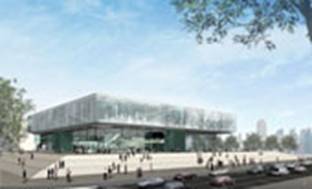Ideal City – Real Projects
dal 28/6/2005 al 2/10/2005
Segnalato da
Architekturmuseum der Technischen Universitat
28/6/2005
Ideal City – Real Projects
Pinakothek der Moderne, Munich
The architects von Gerkan, Marg and Partner in China. With models, photos, drawings and a short film, the exhibition will present the most important projects by gmp in China. The focus will be on the planning of the new city Lingang, whose association to other ideal cities will be illustrated in a separate section containing original historical documents and references.

The architects von Gerkan, Marg and Partner in China
China is at present the largest construction site in the world and in
times of globalization, the internationally best known architects center
there. The transformation of Chinese society, the big flow of migration
from rural to urban areas as well as the industrial settlement of rural
regions are creating a need to plan whole cities out of nothing. One of
the greatest challenges facing architects today, is how modern
architecture can be transferred to China and be adapted to another
culture.
The architects von Gerkan, Marg and Partner (gmp), who have won more
competitions in Germany than any other architectural firm in the last 40
years, are also being more successful in China than all other European
competitors. Over a period of only six years, more than 100 projects
have been drawn up by gmp, of which five have already been completed, 13
are in the planning phase and 30 slated for definite implementation. The
first project realized by gmp was the German School in Peking, the
result of a competition won in 1998. The diversity of their designs and
plans ranges from a museum in Shanghai, an opera and a stadium to
numerous university campuses and residential developments, through to
the National Museum in Peking, currently the biggest museum project in
the world.
The dream of every architect – namely the planning and realization of an
entire city – is to be fulfilled for gmp with their proposal for the new
city Lingang near Shanghai. The metaphoric model of the city’s structure
is the image of concentric waves caused by a drop falling into water.
The focal point of the new metropolis will not be an urbanized
city-center, but a lake with a diameter of 2.5 kilometer and an eight
kilometer long lakefront promenade. Between the promenade and the
bordering green belt will be the center of urban life with offices,
stores, shopping arcades, cultural facilities and apartments. The
concentric structure will be overlapped with streets and lanes arranged
radially, derived from the principle of a wind rose. The new satellite
town was originally planned for 300,000 inhabitants - a figure, however,
which has now grown to 800,000.
With models, photos, drawings and a short film, the exhibition will
present the most important projects by gmp in China. The focus will be
on the planning of the new city Lingang, whose association to other
ideal cities will be illustrated in a separate section containing
original historical documents and references. The section “Urban
Elements†will highlight the National Museum in Peking. All structures
and projects will be elucidated in detail on textile banners resembling
Chinese scrolls.
The exhibition will be accompanied by a catalogue in German and English,
published by Hatje Cantz Stuttgart (190 pages, ca. 250 illustrations)
and will cost 22 euros in the museum shop or 34 euros in bookstores.
On the occasion of the exhibition “Ideal City – Real Projectsâ€, an
evening event entitled “Architectural transfer – talks and discussionsâ€
with Meinhard von Gerkan, Thomas Herzog, Richard Hordon, Christoph
Valentien and Siegfried Zhiqiang Wu will take place on June 30, 2005 at
18.00 in the Audimax of the TU München, main entrance Arcisstrasse 21.
Guided tours through the exhibition will be offered on the following
Thursdays at 18.00: July 7, July 21, Aug. 4, Aug. 18, Sept. 1, Sept. 15 and Sept. 29, 2005.
Press preview: June 29, 2005, 11.00, Temp 1
Opening: June 29, 2005, 19.00
Pinakothek der Moderne
Barer Str. 29 - München



